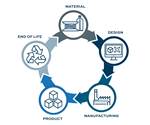What Is the Circular Economy, and How Can 3D Printing Help? (Video)
What does it mean to be sustainable, to manufacture in a circular economy? And where does 3D printing fit? These questions and more answered in this video, the first of our 3D Printing and the Circular Economy series.
How does manufacturing become sustainable? How do we harmonize our production and consumption to reduce waste and keep resources in play for as long as possible?
The answer lies in the circular economy, a concept that describes an ongoing cycle of manufacturing in which used materials, scrap and waste are constantly fed back into the system. The idea takes cues from the regenerative natural world, but applies them to these manmade systems.
Additive manufacturing (AM) and 3D printing technology will be key to establishing a circular economy. All next week, we’ll be posting short, bite-sized videos about each aspect of the circular economy — Material, Design, Manufacturing, Product and End-of-Life — and explore how 3D printing can advance and support more sustainable manufacturing. This initial video explains the circular economy and what it means to be sustainable in more depth; tune in next week for the topic-by-topic breakdown and join the conversation on social media using the hashtag #CircularEconomyWeek.
Resources and Related Links
- Videos in this series: What Is the Circular Economy? | Materials | Design | Manufacturing | Product | End-of-Life
- How Additive Manufacturing Will Aid and Accelerate the Circular Economy
- Why AM and Sustainability Go Together
- Latest stories on sustainability in additive manufacturing
Transcript
Manufacturing needs to change. We need more secure supply chains and more sustainable operations. 3D printing can help.
I’m Stephanie Hendrixson with Additive Manufacturing Media and The Cool Parts Show, and I want to introduce you to our video series on 3D printing and the circular economy. We’ll be bringing you bite-sized videos about each aspect of the circular economy and how it relates to 3D printing and additive manufacturing.
But first, a couple of definitions. What is sustainability? Being sustainable means doing thins in a such a way that allows them to carry on for as long as possible. It’s an ongoing, continuous cycle. The circular economy takes that idea and applies it to our cycles of production and consumption.
You can think about it in contrast to the linear economy, where we take materials, turn them into products, and then those products eventually get discarded. It’s a very clear beginning, middle and end. On the other hand, the circular connects all these things in this continuous, ongoing cycle. The material that’s in play stays in play for as long as possible.
We’ll talk about every aspect of the circular economy in the videos that follow, so if you're interested in learning more, keep watching.
Related Content
-
Sustainable Furniture Company Model No. Maintains Product Focus with Switch from DIY to Industrial 3D Printers
The startup founded in 2018 has matured in its product offerings as well as its manufacturing equipment, moving from homegrown 3D printers to industrial large-format machines.
-
GE Additive Helps Build Large Metal 3D Printed Aerospace Part
The research is part of an initiative to develop more fuel-efficient air transport technologies as well as a strong, globally competitive aeronautical industry supply chain in Europe.
-
How 3D Printing Aids Sustainability for Semiconductor Equipment: The Cool Parts Show Bonus
Hittech worked with its customer to replace fully machined semiconductor trays with trays made via DED by Norsk Titanium. The result is dramatic savings in tool consumption and material waste.

.jpg;width=70;height=70;mode=crop)








